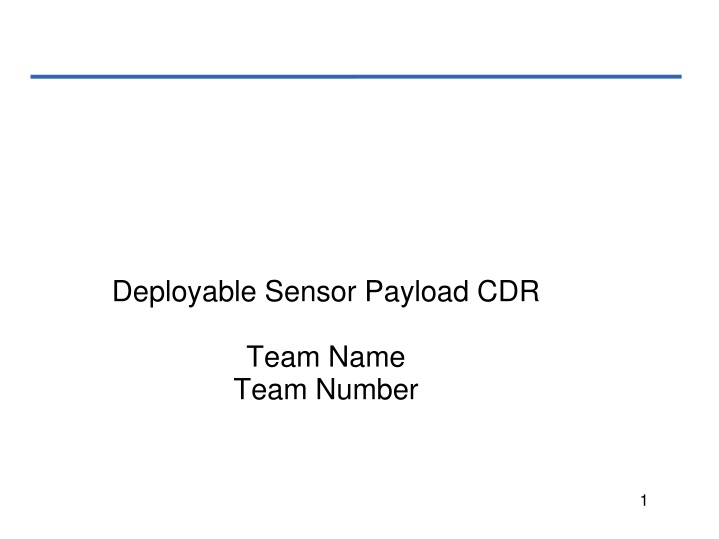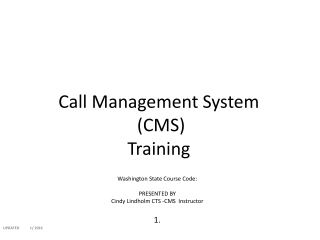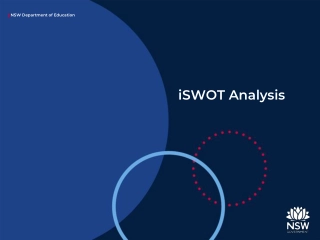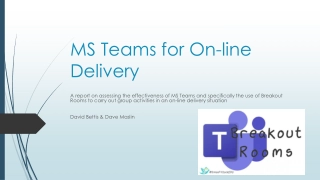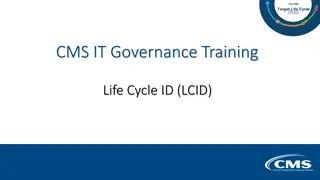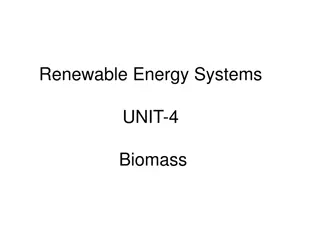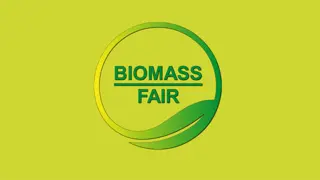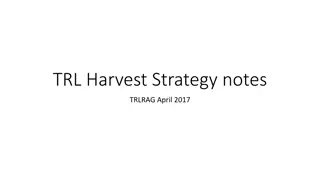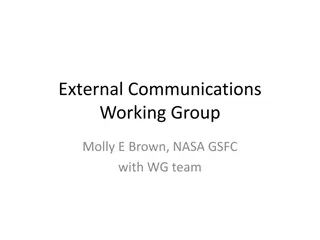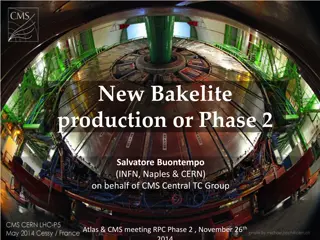Breakout Sessions: CMS Science Team & Stakeholders - Biomass Survey & SWOT Analysis
This content presents Breakout Sessions between CMS Science Team Members and Stakeholders focusing on a Brief survey on the use of CMS biomass products by stakeholders along with a SWOT Analysis for the CMS Program Biomass and Stakeholder Focus. The session also delves into the spatial resolution preferred for biomass/carbon monitoring applications. The activities encompass cutting-edge technology, data tailored stakeholder engagement, and collaboration for the NASA CMS Program.
Download Presentation

Please find below an Image/Link to download the presentation.
The content on the website is provided AS IS for your information and personal use only. It may not be sold, licensed, or shared on other websites without obtaining consent from the author.If you encounter any issues during the download, it is possible that the publisher has removed the file from their server.
You are allowed to download the files provided on this website for personal or commercial use, subject to the condition that they are used lawfully. All files are the property of their respective owners.
The content on the website is provided AS IS for your information and personal use only. It may not be sold, licensed, or shared on other websites without obtaining consent from the author.
E N D
Presentation Transcript
Deployable Sensor Payload CDR Team Name Team Number 1
Instructions Slides are a template describing information needed. Each section can be expanded into more slides as needed. Don't try cramming each listed topic on the same slide. Place team/school logo in the top left corner. Formatting and background can be customized. Do not include animations or videos as reviewers may not have compatible software. Submit CDR in pdf format for maximum compatibility. A PDR should focus on trade studies, CDR should focus on final design. Use consistent units (metric or standard). Do not include this slide in the presentation. Yes, someone will. 2
Presentation Outline Provide a simple outline of the presentation Indicate team member(s) who will present each section 3
Team Organization Single slide listing team members and role Can use an organization chart 4
Acronyms Provide a list of acronyms used throughout the presentation Used as reference only. Does not need to be read through 5
Mission Summary Overview of mission objectives Include any external objectives 7
System Requirement Summary Overview of system (mission) level requirements Use table to demonstrate understanding of requirements Include requirements for the payload Include requirements for the rocket 8
Changes Since PDR Identify all changes since PDR in overall design 9
System Level Design Present preliminary system-level concept design Configuration of rocket and payload Include sketches and diagrams of various concepts considered. 10
System Concept of Operations Provide overview of operations of the system from launch to landing to Payload operations. Launch and descent operations Payload operations Post-launch recovery Simple flow diagrams and cartoons are a good way to present the CONOPS 11
Changes Since PDR Identify all changes of the rocket design since PDR 13
Design of Rocket Describe overall rocket design A drawing of the rocket identifying all of its components and dimensions Length and diameter Identify major components and locations Nose cone Number of fins and size Location and size of rail buttons Location of avionics bay if using electronics deployment with altimeter(s) Total on the pad weight of the rocket with the primary and backup motors. This includes: All recovery harnesses and parachutes Primary or backup motor 14
Design of Rocket (continued) Identify the rocket s stability. The center of gravity (CG) must be ahead of the center of pressure (CP) by at least one diameter (caliber) of your rocket. With primary motor With backup motor Motor retention method Friction fit is specifically disallowed 15
Rocket Materials List of materials used: Airframe material Fin material Nose cone material Type of adhesives used Rail button source and material 16
Rocket Recovery System Parachute selection Size of and how determined Identify method for protecting parachute and rationale for choice Dual deploy? What is the expected descent rate(s) Harness Show drawing of recovery harnesses for each part of the rocket Type of shock cord, lengths and strengths Identify linkages and load limits Attachment points, eyebolts, fender washers, etc. and their mounting methods 17
Rocket Recovery System Deployment Method Document method of initiating recovery Altimeter(s) Parachute release mechanism Motor ejection - specify motor delay in seconds for Primary motor Secondary motor Any rockets using VMAX motors must use an altimeter that deploys the parachutes as per Tripoli and NAR rules. 18
Rocket Recovery Electronics - if used Identify which commercial altimeter(s) will be used Show wiring diagram of altimeters with charges Document the number and size of the pressure ports for altimeter Document altimeter preparation steps. Specify the quantity of black powder to be used to separate each section Specify the volume of the section to be pressurized with calculated pressure level Document charge size testing and results Specify how sections are secured before the ejection charges separate sections friction fit shear pins - number and size Other Identify how charges are fired e-matches other 19
Rocket Motor Selection Identify primary motor selection Calculate thrust to on pad weight ratio using average thrust of the primary motor Thrust to weight ratio must be a minimum of 5:1 Identify back up motor selection and what changes to rocket would be required to successfully comply with contest rules Calculate thrust to on pad weight ratio using average thrust of the backup motor Thrust to weight ratio must be a minimum of 5:1 Include a simulation plot for the primary motor Include a simulation plot for the backup motor 20
Altitude Recording Altimeter Identify the commercial altimeter to be used to officially record the rocket s altitude If using a commercial altimeter for deployment, it can be designated the altitude recording altimeter 21
Payload Design Overview Show block diagram or picture of payload Identify major components Dimensions 23
Changes Since PDR Identify all changes of the payload design since PDR 24
Aerobraking Descent Control Describe how payload descent is controlled Shape Structural Design Descent rate calculation 25
Parachute Descent Control Describe how payload descent is controlled Shape Color Descent rate calculation Attachment to payload Parachute Release Method 26
Mechanical Layout Mechanical design of payload Show structure of Payload Identify location of major components Identify major mechanical parts 27
Payload Mass Budget Show mass of all components of the selected design Mass of each structural element in grams Sources/uncertainties whether the masses are estimates, from data sheets, measured values, etc. Total mass of all components and structural elements Margin : The amount of mass (in grams) in which the mass budget meets, exceeds, or falls short of the mass requirement 28
Payload Electronics Electronic block diagram showing all major components Processors Memories Sensors Drivers for mechanisms and actuators 30
Changes Since PDR Identify all changes of the electronics design since PDR 31
Processor and Memory Selection Describe final selection Specs of processor Power consumption Speed Interfaces 32
Sensors List sensors used in payload Function Manufacturer Specs Power consumption 33
GPS Sensor GPS receiver Manufacturer Specs Power consumption 34
Ground Station Link Payload Radio Describe Radio selected Manufacturer Frequency Power consumption 35
Ground Station Link Payload Radio Antenna Describe antenna selected Manufacturer Frequency Mounting method Location 36
Payload Power Battery selection Manufacturer Battery configuration Power capacity Mounting method Protection circuits Short circuit Over-discharge for lithium ion cells 37
Payload Power Distribution Electrical Power System Design Block diagram Power distribution to subsystems, mechanisms, actuators 38
Payload Power Budget List power consumption of all electrical components All values are to be in watt-hours Compare to capacity of the battery in watt-hours Document how long the Payload can operate on the battery(ies) 39
Software 40
Changes Since PDR Identify all changes of the software design since PDR 41
Payload Software Design Flow Chart of the payload software Identify the software states and how software transitions to each state Power up Integration Launch Transmission (bonus) Landing 42
Software Development Plan Describe the software development plan Include Prototyping and prototyping environments Software subsystem development sequence Development team Test methodology 43
Payload Integration - Construction of payload section - Integration Process 44
Changes Since PDR Identify all changes of the ground station design since PDR 46
Ground Station Design Show block diagram of ground station Identify all major components 47
Ground Station Radio Description of radio Manufacturer and model Frequency Transmit power level 48
Ground Station Antenna Description of antenna Type of antenna Antenna pattern Range calculation Identify if mounted or hand-held 49
Ground Station Software Telemetry display (show prototype of display) Identify any commercial or open source software packages to be used Real time plotting if implemented 50
